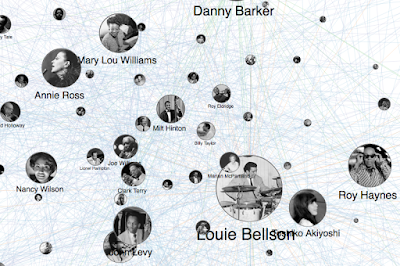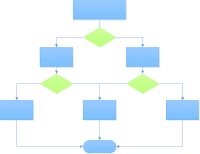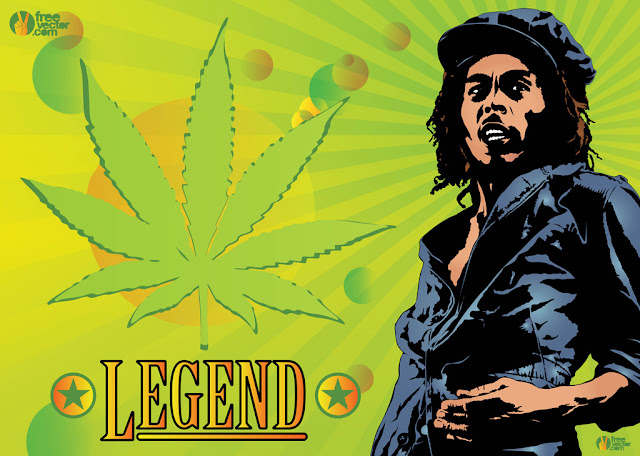Just how feasible are genre-specific workflows in online and remote music learning? We explore the idea in the context of a world music instrument and theory tool visualisation framework created with the aim of supporting P2P or distance music learning.
What gives a genre it's particular groove, tension or mood? A dynamic, visual-model-based paradigm provides us with the means to take a fresh look at many aspects of music, not the least being the core modal, rhythmic and stylistic elements of genre, and how we can ease a new learner's transition into it..
Big, brave, open-source, non-profit, community-provisioned, cross-cultural and catflap crazy. → Like, share, back-link, pin, tweet and mail. Hashtags? For the crowdfunding: #VisualFutureOfMusic. For the future live platform: #WorldMusicInstrumentsAndTheory. Or simply register as a potential crowdfunder..
The goal of any aspiring instrumentalist is usually to find a given genre's groove, yet the tools to explore rhythms, modal contexts, techniques and instrumentation dynamically have to date been limited.
Music visualisation is a game changer. We have an opportunity not just to identify the key components of genre, but to quantify them, trace their origins, associate them, and even lend them an own (albeit fuzzy) digital signature.
Genre-specific workflows open up countless exploration possibilities, but also practical and commercial uses.
The Elements of Genre, Technique and Style
A given genre spans a wide range of characteristic structures, conventions and models. If seeking a broader (and above all visual) understanding of genre, we need to be able to identify those elements central to character, or those acting as anchors between different them, while not getting drawn too deeply into detail.
Taking reggae as an example, we try to get closer to a model of wider practical application.
Genre with Timeline
We have seen already seen a variety of classification trees, including one example for genre. A genre chart can, however, be adapted to display a development timeline, as below. In doing so genre information assumes a historical perspective.
The means now exist to convert such historical development charts to into fully interactive, fine-grain linkable visualisations.
While this particular diagram does not cover earlier music-cultural developments of impact on reggae, hopefully you see the potential..
Reggae can, incidentally, be found just south of center.. :-)
Influences
 |
| LinkedJazz.org |
Within genre, perhaps one of the most useful insights are the influences of musicians on each other.
This has been demonstrated very nicely for Jazz musicians in the LinkedJazz visualisation tool, which builds on the availability of several discrete but publicly available datasets from (for example) Wikipedia, the Smithsonian Institute, UCLA and the Rutgers Institute.
Linking Data Together
One of the great strengths of recent database developments the ability to map ad-hoc in innovative but simple ways. Graph and hybrid databases allow nodes in otherwise unrelated classification trees to be linked to each other, the key to linking workflows and data.
Clearly workflows are a matter for individual teachers. Indeed graphical creation and management of workflows has been achieved by a number of independent companies. How this could be implemented consistently within our visualization aggregator platform is a matter for further study. Going by other's results, however, this is entirely feasible as a goal.
Moreover, it's implementation seems likely to lie in the realm of widely used and well documented event handling and drag'n'drop techniques. As we have often seen, solutions -including open source ones- seem almost to find the corresponding problems on their own over time.
Musical Form / Style
Origins in Ska via Rocksteady
Roots, lovers rock, dub and dancehall
--> characterisable by sound clips
Culture / Message
Politics and religion (Rastafarian), reaching promised land (Ethiopia/Africa).
Altered states with the aid of "ganja" - marijuana ("wisdom weed" or "holy herb").
--> characterisable by central tenets of philosophy or culture, in text or image form
Time Signatures
With symmetrical rhythmic patterns, reggae is pretty much restricted to 4/4 rhythm. Tempo is slow and steady.
--> characterisable using a combination of score and rhythmic tool
Rhythmic Structures
From time to time, music magazines will feature some aspect of reggae, be it drum rhythms, or bass or guitar conventions.
Though drum synthesizers can hold whole libraries of reggae beats, to my knowledge no-one has attempted to create a single, interactive visual repository.
This is an area where community generated content could really make a difference.
Of possible interest to learners is how often a given rhythm is actually used within given genre. This is a valid concern in as much as learners profit from knowing that what they assimilate is likely to find practical application.
--> characterisable using a combination of score and rhythmic tool
Modes
Ok, a lot of reggae music is played in a minor key. What is not so clear is if other musical modes are exploited, and if so, why.
As it happens, pentatonic scales feature widely, as do major, minor and blues scales.
Though such scales or modes find expression on many instruments and tunings, the guiding context for reggae is lead or bass guitar in standard tuning. Here (LHS) for lead guitar.
There are, of course, many other ways of visualising these.
--> characterisable using a combination of score, instrument model and theory tool
Instrumentation
Typical for reggae are rhythm and lead guitar, syncopated bass and drums, with (to a lesser degree) organ, brass, melodica.
 |
| Bass Guitar Configuration |
No problem. Here we can resort to our world instrument models, though we apparently need to extend our tunings to cover standard bass (E, A, D, G).. :-)
--> characterisable by instrument models
Sheet Music
--> access to creative commons / open source sheet music archives
Timbre
There are many options for audio embedding, but those that interest us most are community-driven, freely available and open source. Examples?
Other approaches exist, such as music pre-cleared for certain types of uses by the rights-holders themselves:
External archives come at the risk of link die-off, but there is a some likelihood native platform users will be able to provide own video or sound examples demonstrating specific instruments, techniques and styles, and -judging by Freesound's community activity- a good chance that individuals will respond to requests for specific types of recording.
--> characterisable by instrument video and sound clips
Technique
Palm mute, off- (or back-) beat, emphasis on 3rd (upstroke) beat, call-and-response, triad chords for clarity.
Here we find ourselves in our teacher's hands. A minute or two of demonstration (video chat), a little cross-check, and on we go.
--> characterisable on instrument models, video, audio and through P2P teaching
Etymology
To every culture, there are an often unique terminology covering rhythms, instruments, technique and style. Often our first encounter hints at origins, as with 'roots', 'dub', 'reggae rock', 'American' or 'Spanish'.
Why are these important? They provide clues as to central tenets of genre, in some cases providing genre subclassifications (branches).
Reggae rhythm examples?
Skank: the staccato chords played by a guitar on the offbeat
One drop: emphasis entirely on the backbeat
Rockers: emphasis on all four beats of the bar (usually on bass drum).
Steppers: bass drum plays every quarter beat of the bar, giving an insistent drive
Riddem:<sigh>
Where there are no native visualisation opportunities, we need to look for useful associations, mappings and labelling opportunities within the notation, instrument and theory areas.
--> characterise central tenets of philosophy or culture, finding expression in classification, text or image form
The Challenge
For each of the above, the challenge is first to find suitable visual models, and then to link these in a way that makes beginner orientation and navigation simple and intuitive, the goal being provision of a sufficient but solid, genre-authentic introductory reference model.
At our disposal we have all our instrument models and theory tools, but additionally their classification trees and ad-hoc exercises and contextual diagrams.
There are, moreover, additional resources outside our aggregator platform, in the form of activity across a whole slew of social mediat platforms.
 |
| IFTTT Affiliated Sites |
Take, for example, an intriguing service by the name of IFTTT (If this then that).
Given an event within one of the social media sites in their directory, IFTTT can trigger an action in any of the others - for example to set up automatic notification of new resources of use within our aggregator platform.
Simple screening and allocation by authorised platform users could -given the suitable licensing conditions- be used to populate certain parts of the system with useful media.
Possible candidate sources with musical leanings from amongst IFTTT's connected services? Soundcloud, Youtube, plus countless specialist groups on Google+ and Facebook..
Navigation
Central to possible workflows is consistent, widely applicable navigation - above all between classification trees. Where data (classification/storage structure) design can make or break your application, navigation between between this structures brings freedoms. These paths will often be different for each music genre.
 |
| Example relations between Music Visualisation Data Stores |
xWhere data has already been retrieved, correlation can of course be done in front end code, but this is likely to be the exception.
Each teacher should be in a position to bring together the information specific to own methods and goals. However retrieval and comparison is achieved, underlying this we will need a user-defined means of defining workflows.
 |
| Workflow Composer |
At heart, we have two clear data interaction use cases. One concerns writing musical data to and it's retrieval from storage structured around a specific classification tree (example: saving and retrieving and instrument definition), the second (example: "find a lute family instrument with seven strings known to have been used in gypsy music") stitching together data stored across (possibly several) disparate classification trees.
Underpinning this are the database and how queries are made on it. Clearly, the more precise the query, the more relevant the response - but the tighter the potential coupling between client and server. This is the topic of a future post.
Keywords
online music learning,
online music lessons
|
distance music learning,
distance music lessons
|
remote music lessons,
remote music learning
|
p2p music lessons,
p2p music learning
|
music visualisation
music visualization
|
musical instrument models
interactive music instrument models
|
music theory tools
musical theory
|
p2p music interworking
p2p musical interworking
|
comparative musicology
ethnomusicology
|
world music
international music |
folk music
traditional music
|
P2P musical interworking,
Peer-to-peer musical interworking
|
WebGL, Web3D,
WebVR, WebAR
|
Virtual Reality,
Augmented or Mixed Reality
|
Artificial Intelligence,
Machine Learning
|
Scalar Vector Graphics,
SVG
|
3D Cascading Style Sheets,
CSS3D
|
X3Dom,
XML3D
|










Comments, questions and (especially) critique welcome.